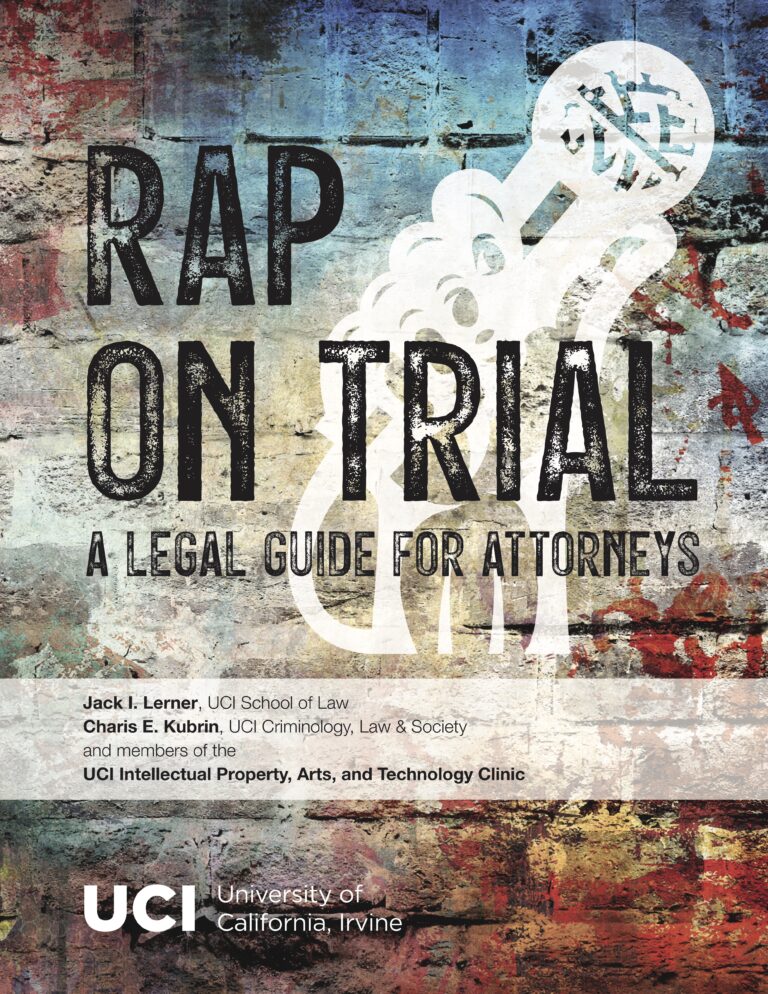Rap lyrics have been introduced as evidence in hundreds of cases, and a high-profile ruling by the Maryland Court of Appeals recently allowed a few lines of rap to help put a man behind bars for 50 years. Yet not only is rap music protected by the First Amendment, but previous UCI research has found that such lyrics can bring out anti-Black racism in jurors.
“Putting rap lyrics on trial is a practice that continues unabated as a way to sidestep the hard work of a case and cut corners to get convictions,” said lead author Jack Lerner, clinical professor of law at UCI. “Prosecutors are relying on stereotypical, exaggerated, hyperbolic, graphic lyrics and videos to make the jury think that if someone could write this, they could do it.”
The new guide serves as a comprehensive resource for attorneys dealing with rap lyrics introduced in any stage of criminal proceedings – from initial discovery to trial to sentencing. It includes explanations of common rap conventions that may be unfamiliar to lawyers and jurors, an overview of empirical research on rap and bias, legal grounds for evidentiary and First Amendment challenges to admitting lyrics into a trial, and even suggestions for jury selection. Along with the guide, the authors provide a collection of cases involving rap lyrics and a set of relevant court briefs.
“This is an epidemic that’s been going on for a long time,” said Charis Kubrin, professor of criminology, law & society and co-author of the guide. “Finally, attorneys have a resource they can turn to and discover the number of courts that have actually said no to rap on trial.”
Kubrin, who has provided expert testimony in high-profile trials involving rap lyrics, started working with Lerner on the guide after discovering a manual published by the American Prosecutors Research Institute that urged prosecutors to use rap lyrics to “invade and exploit the defendant’s true personality” and recommended that investigators focus on such items during the execution of search warrants and arrests.
Previous research by Kubrin has shown that rap lyrics activate bias in potential jurors. The same lyrics are viewed as more dangerous, offensive, threatening and literal when people are told they’re from rap versus a country song.
Law students in the UCI Intellectual Property, Arts & Technology Clinic, directed by Lerner, contributed to the development of the guide over two years. The Rap on Trial Legal Guide, as well as a compendium of court cases and relevant briefs can be found at endrapontrial.org.
About the University of California, Irvine School of Law: UCI Law is a visionary law school that provides an innovative and comprehensive curriculum, prioritizes public service, and demonstrates a commitment to diversity within the legal profession. UCI Law students have completed more than 123,000 hours of pro bono work since 2009. Forty-six percent of UCI Law’s graduates are students of color. At UCI Law, we are driven to improve our local, national and global communities by grappling with important issues as scholars, as practitioners and as teachers who are preparing the next generation of leaders. The collaborative and interdisciplinary community at UCI Law includes extraordinary students, world-renowned faculty, dedicated staff, engaged alumni and enthusiastic supporters. More information on UCI Law is available here. Please follow us on Twitter @UCILaw and Facebook @UCIrvineLaw.
About the UCI Intellectual Property, Arts & Technology Clinic: Law students in the UCI Intellectual Property, Arts & Technology Clinic work to support innovation and creative expression in the digital age. They advise and represent clients on a range of matters dealing with copyright, patent, privacy and media law, among other areas. Through this work, students gain important legal skills while examining the role of the public interest in intellectual property and technology law. More information on the clinic is available here.
About the University of California, Irvine: Founded in 1965, UCI is the youngest member of the prestigious Association of American Universities and is ranked among the nation’s top 10 public universities by U.S. News & World Report. The campus has produced three Nobel laureates and is known for its academic achievement, premier research, innovation and anteater mascot. Led by Chancellor Howard Gillman, UCI has more than 36,000 students and offers 224 degree programs. It’s located in one of the world’s safest and most economically vibrant communities and is Orange County’s second-largest employer, contributing $7 billion annually to the local economy and $8 billion statewide. For more on UCI, visit www.uci.edu.
Media access: Radio programs/stations may, for a fee, use an on-campus ISDN line to interview UCI faculty and experts, subject to availability and university approval. For more UCI news, visit news.uci.edu. Additional resources for journalists may be found at communications.uci.edu/for-journalists.



